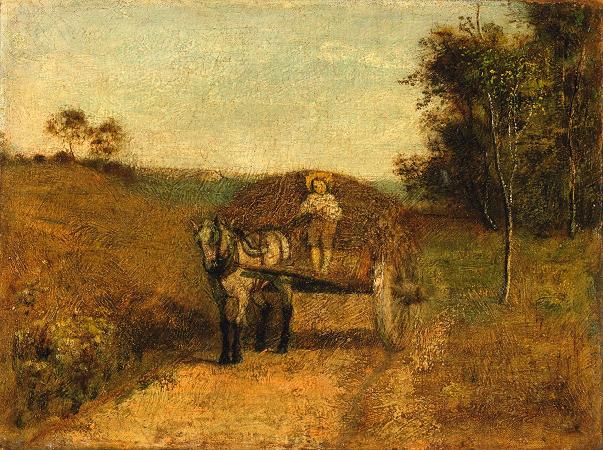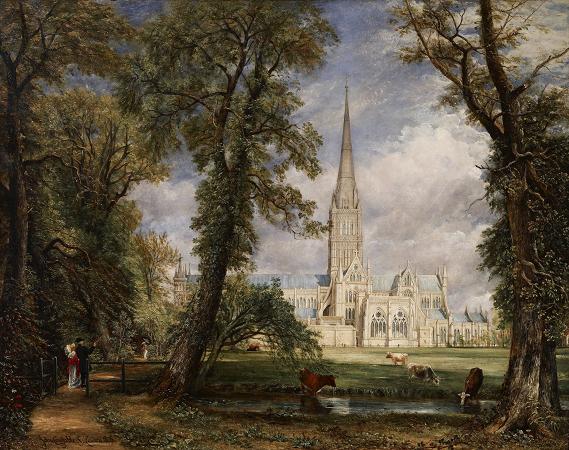Landscape with Wagon. A wagon or waggon is a heavy four-wheeled vehicle pulled by draught animals or on occasion by humans, used for transporting goods, commodities, agricultural materials, supplies and sometimes people. Wagons are immediately distinguished from carts and from lighter four-wheeled vehicles primarily for carrying people, such as carriages. Animals such as horses, mules, or oxen usually pull wagons. One animal or several, often in pairs or teams may pull wagons. However, there are examples of human-propelled wagons, such as mining corfs. A wagon was formerly called a wain and one who builds or repairs wagons is a wainwright. More specifically, a wain is a type of horse-or oxen-drawn, load-carrying vehicle, used for agricultural purposes rather than transporting people. A wagon or cart, usually four-wheeled; for example, a haywain, normally has four wheels, but the term has now acquired slightly poetical connotations, so is not always used with technical correctness. However, a two-wheeled haywain would be a hay cart, as opposed to a carriage. Wain is also an archaic term for a chariot. Wain can also be a verb, to carry or deliver, and has other meanings. Contemporary or modern animal-drawn wagons may be of metal instead of wood and have regular wheels with rubber tires instead of traditional wagon wheels. A person who drives wagons is called a wagoner, a teamster, a bullocky, a muleteer, or simply a driver. The exact name and terminology used are often dependent on the design or shape of the wagon. If low and sideless it may be called a dray, trolley or float. When traveling over long distances and periods, wagons may be covered with cloth to protect their contents from the elements; these are covered wagons. If it has a permanent top enclosing it, it may be called a van. Main article: Front axle assembly A front axle assembly, in its simplest form, is an assembly of a short beam with a pivot plate, two wagon wheels and spindles as well as a drawbar attached to this. A pin attaches the device to a chariot, a wagon or a coach, making the turning radius smaller. Wagons have served numerous purposes, with numerous corresponding designs. As with motorized vehicles, some are designed to serve as many functions as possible, while others are highly specialized. This section will discuss a broad overview of the general classes of wagons; for details on specific types of wagons, see the individual links. Beach wagons are collapsible folding wagons for general multi-purpose usage on outdoor sand beaches. Farm wagons are built for general multi-purpose usage in an agricultural or rural setting. These include gathering hay, crops and wood, and delivering them to the farmstead or market. Wagons can also be pulled with tractors for easy transportation of those materials. A common form found throughout Europe is the ladder wagon, a large wagon the sides of which often consisted of ladders strapped in place to hold in hay or grain, though these could be removed to serve other needs. A common type of farm wagon particular to North America is the buckboard. Freight wagons are wagons used for the overland hauling of freight and bulk commodities. Freight wagons were designed for hauling loads, not people, and were not built for comfort. A driver did not have a seat in front of the wagon like the image most people have of wagons. A driver walked along side the wagon or rode on top of one of the horses. There was no place in front for a person to sit. Many freight wagons, however, had a unique feature called a lazyboard. This was a plank that could be pulled out and sat on, and then pushed back in if not needed. It was located on the left side of the wagon between the wheels and close to the brake. If a driver was too tired to walk, he could pull out the lazyboard, and take a rest. That is why it was called a lazyboard. In America, lazyboards were located on the left side because carts were steered from the left side. The cart itself was on the right side of the road. Unless a driver wanted to walk in the ditch, he had to steer from the left side In Europe, carts were steered from the right side. The cart itself was driven on the left side of the road, as vehicles are driven there today. A European freight wagon had its lazyboard on the right side. In both places the driver would walk in the center of the road. More than a hundred years ago, almost everyone knew what a lazyboard was.
more...









